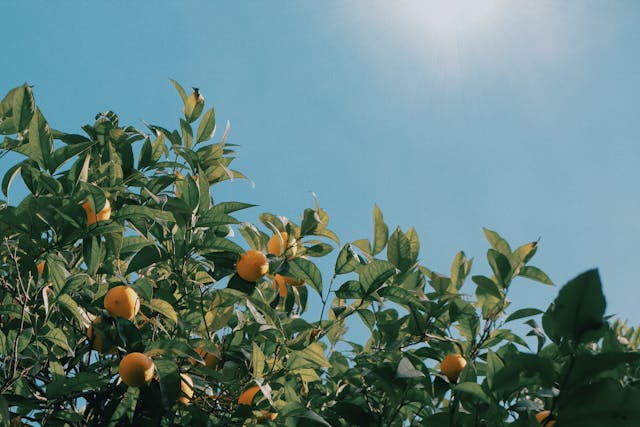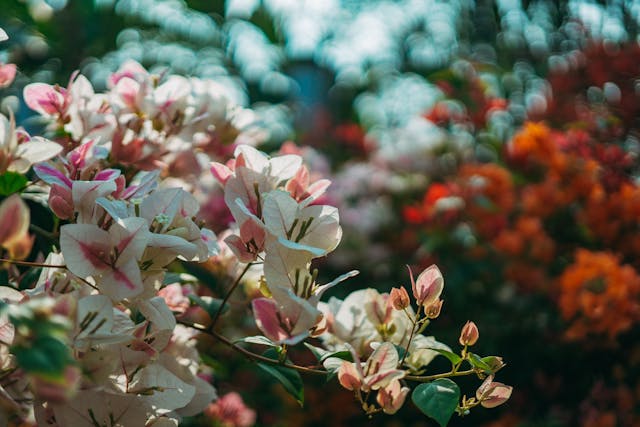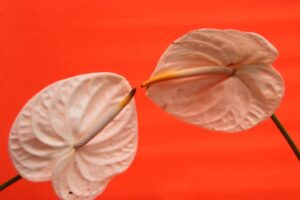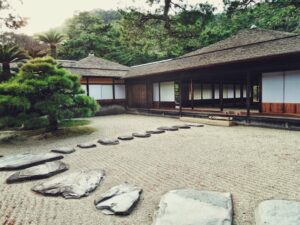The stud farm and gardens at Mauritzfontein are a verdant oasis nestled between the vast, dry Karoo to the south and the Kalahari desert to the north, in the Northern Cape Province of South Africa. This location places the estate between the two most severe climate zones in the country. Large plains of short grass are the nearby topography, broken up by koppies, or rocky hills, and boulders. To the horizon are low shrubs, termite mounds, and camel thorn trees. The temperature ranges greatly, with summer highs of 49°C and winter lows of -8°C. The sky is quite large. The Karoo was named after its indigenous inhabitants, the Khoisan people, who referred to it as “the land of thirst” because it lacked surface water. This is the vast, dry terrain that envelops the 22-acre Mauritzfontein gardens.

Founded by Bridget and Harry Oppenheimer in 1947 with the goal of producing thoroughbred racehorses, Jessica Jell and her husband Steven now manage the stud. The property’s green core, however, is its gardens, which were created in the late 1950s by renowned landscape architect and environmentalist Joane Pim of South Africa.
Joane was a formidable individual much ahead of her time. She was a driving force behind the introduction of native South African plants into gardens and a strong supporter of organic gardening. In her first notes on planning and planting this space, Joane said, “The goal was not to lay out a garden in the conventional sense, but to restore a small portion of the African landscape as it once might have been.” Nearly 70 years later, under the skilled supervision and management of horticulture and landscape designer Arthur Mennigke and his staff, Joane’s vision has gained fresh ground.
Arthur has given the gardens new vitality by connecting them into a network of interconnecting garden rooms, all the while staying faithful to Joane’s original design. His approach to plant selection and combination-making has become more fun and dynamic due to the microclimates he has created over many decades. Because of his ecological concentration, the work is now softer and more realistic than it was in many places. An amazing illustration of this may be seen in the freshly installed “river of grasses” that crosses the main lawn. Towering stinkwood trees, white karee, and African olives still stand in Joane’s background, along with other shade-loving giants, but the green river has brought the veld’s vitality to life. The meadow and dam at the base of the garden are surrounded by snowflake, silky bushman grass, weeping lovegrass, ngongoni, and herringbone grass.
The meadow is the place where nature has been let to run its course. Now in its fourth season, it’s an inspirational experiment with no weeding or cutting that has helped thousands of storm lilies that haven’t been seen since Joane’s time, as well as pioneer grasses, indigenous grass species, and prized gladiolus bulbs, to joyfully re-establish. This region is alive with the sounds of birds such as brown-hooded kingfishers, finches, crested barbets, and common waxbills, in addition to the native vegetation.
From the main lawn, stone steps and walkways lead to the woods and succulent gardens. The pathways are made of naturally existing dolerite rock. The red stone, called ysterklip in Afrikaans, is a distinguishing characteristic. Paths wind and meander, while plantings of aloes and other plants that have been let to stray into the wild, disobeying original borders and obscuring the distinction between veld and garden, also meander and drift in and out.

According to Arthur, the succulent garden has the strongest visual and climatic connection to the surrounding area. There’s hardly much up here to protect the plants from the weather. The sun is quite harsh, the wind is strong, and there may be very severe frosts. Due to their high water content, succulents and aloes are prone to “melting” following winter frosts due to their spongy leaves. The succulent garden is thus not watered from May to October. As one person put it, “It’s an exercise in trial and error—you have to work with nature here, never against it.”
The forest garden offers relief from the intense summer heat. Under their canopies, native shrubs like bluebush, yellowwoods, and kei apple trees—some of which reach heights of over nine meters—create a natural refuge for shade-loving clivia, asparagus ferns, foamy plectranthus, cotyledon, and drifts of chlorophytum. The vegetable and cutflower garden is located to the west of this peaceful haven. The outcome is distinctively African, although drawing inspiration from the walled kitchen gardens seen in England and France. The walks are composed of compacted red dirt from former termite mounds; the garden is surrounded by dry-packed ysterklip walls; and wood buildings, supports, and trellises are fashioned from gum poles. Everyone talks about having deep roots in the Karoo terrain.

Successful gardening in this area directly correlates with one’s experience, sense of intuition, and comprehension of the local circumstances and rhythms. Though in this case it really is make or break, they are characteristics that guarantee the life of any garden. The very alkaline water significantly reduces the variety of plants available. There is a lot of wildlife in the gardens, including vervet monkeys, warthogs, porcupines, and duikers, as well as other local opportunists that like to nibble on the beautiful flowers. The renowned storm lily and other bulbs are dispersed as a countermeasure against porcupine damage, and warthogs help keep the grass short in some places. The hardworking gardening crew is now proficient in recognizing veld plants that were formerly thought to be weeds and welcomes these untamed species since they improve soil health and boost biodiversity.
Storm lilies on the major grass meadows, usually a harbinger of impending rain.
Maringales from Africa in the cutting garden.
After a July rain, steam rises from heated rocks beside the forest garden.
The vegetable garden’s entry is marked with gum poles covered in wisteria.
A distinguishing feature are the paths that wind through the succulent gardens and forest.
A creek in the garden of forest.
Succulent garden on the far north edge of the land, distinct from other sections of the property by specialist plant species. Here, flowered Aloe grandidentata in the center and spiky Aloe ferox to the right are overshadowed by a mature, weeping boer-bean tree.



